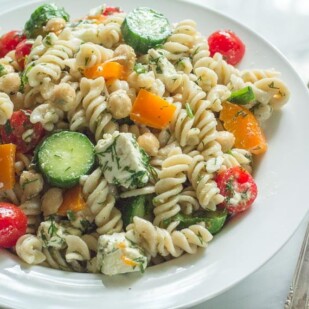Pasta all’Amatriciana in Less Than 30 Minutes
Let’s learn to make Pasta all’Amatriciana!
Every Sunday in the fall and winter my parents and I would drive home from the Catskills from a weekend of skiing – and dig into a quick hot meal, such as Pasta all’Amatriciana.

Classic Dishes, FODMAPed
This meant that after the 2 ½ hour drive home from Shandaken, NY to NYC we needed a quick dinner. Now, mind you that this was the 60s and the 70s and the “Italian cuisine” most Americans knew was an American approximation.
My Dad, however, spoke 8 languages and his travels took him all over the world. He also spent many years living in Europe. He loved to reproduce the traditional foods of his travels and Sunday night became pasta night.
Quick and Easy
So many pasta dishes are Quick and Easy and he had a treasure trove of recipes up his sleeve. From a classic puttanesca, briny with anchovies, to a creamy carbonara and the much-beloved fettuccine Alfredo, we never went hungry.
My father would go on and on about tasting the original Alfredo sauce at its birthplace, being taught how to make it by the originators and that he was also given a golden spoon and fork with which to re-create the dish – just like they did at the restaurant. More on Alfredo another time.
The History of This Sauce
This story is about his Pasta all’Amatriciana. This classic Italian sauce was named after the Italian town of Amatrice, just eastward from Rome, and features cured pork (either guanciale from the jowl or pancetta from the belly), olive oil, spicy red pepper flakes, a good amount of black pepper, tomatoes and sharp Pecorino cheese.
Traditionally it is served with bucatini, which might look like fat spaghetti, but is actually hollow, like a long straw. This pasta shape is excellent at capturing bits and pieces of the flavorful sauce inside the pasta, but as no gluten-free version exists as of yet, I use spaghetti. You can find our gluten-free favorites in our Shop.
Add Pecorino Romano
The authentic Pecorino Romano sheep’s milk cheese is saltier than Parmesan and has more of an assertive bite. It works very well here to balance the sweet acidity of the tomatoes and the hot black and red peppers. You could substitute Parmesan, but it wouldn’t be the same.
And by the way, while many Amatriciana versions include onion and/or garlic, there are just as many, if not more, that leaves them out. This was one reason why the dish was calling out for a FODMAP makeover.
By simply replacing traditional pasta with gluten-free, you can have a quick weeknight low FODMAP meal on the table that is very close to the Roman classic.
Also be sure to check out our Low FODMAP Bolognese for you meat lovers!

Pasta all’Amatriciana
Pasta all'Amatriciana is a quick and easy traditional pasta dish that takes advantage of pantry ingredients that you should always have on hand: dried pasta, canned tomato products, olive oil and garlic-infused olive oil. The pancetta can be frozen, so consider keeping it around too.
Ingredients:
- 1 tablespoon extra virgin olive oil; you may use garlic-infused if you like such as FODY Foods garlic-infused olive oil
- 4 ounces (115 g) guanciale or pancetta, cut into small strips
- 1/2 teaspoon red pepper flakes
- Freshly ground black pepper
- 1/4 cup (60 ml) dry white wine
- 1, 28 ounce (794 g) can diced tomatoes
- 1 pound (455 g) low FODMAP gluten-free low FODMAP spaghetti, such as Jovial brand
- 1/4 cup (25 g) grated Pecorino Romano, plus extra
Preparation:
-
Heat oil in a large heavy, wide skillet over medium heat. Add guanciale or pancetta and sauté until beginning to crisp and color, about 4 minutes. Add pepper flakes and a generous amount of black pepper; stir for 10 seconds. Turn heat up to medium-high. Add wine, scraping up any browned bits on the bottom of the pan, and continue to cook for a few minutes, stirring often, or until the wine has almost all evaporated but the mixture still looks a bit juicy.
-
Add tomatoes, reduce heat, and simmer until sauce has thickened, stirring occasionally. This will take about 15 or 20 minutes - the time it will take you to cook the spaghetti itself.
-
Bring a large pot of salted water to a boil. Add spaghetti and cook, stirring now and then, until it is firmer than al dente. It is very important not to completely cook at this point. Drain pasta, reserving 1 cup of pasta cooking water.
-
Add drained pasta to sauce in skillet over low-medium heat and use tongs to toss and thoroughly coat with sauce. Add reserved water, a few tablespoons at a time, and keep tossing until sauce comes together with pasta is coated evenly and well. Toss in cheese and serve immediately, with extra cheese passed around.
Notes:
Tips
- Please do seek out the guanciale or pancetta for this dish. You could use bacon, and it would be tasty and still low FODMAP, but it wouldn't be true to classic Pasta all’Amatriciana.
Nutrition
All nutritional information is based on third-party calculations and should be considered estimates. Actual nutritional content will vary with brands used, measuring methods, portion sizes and more. For a more detailed explanation, please read our article Understanding The Nutrition Panel Within Our Recipes.
For more tomato-based recipes, we have a round-up for you with plenty of inspiration.









